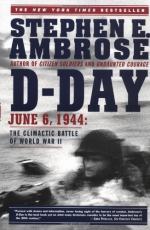|
This section contains 631 words (approx. 2 pages at 400 words per page) |

|
D-Day, June 6, 1944: The Climactic Battle of World War II Summary & Study Guide Description
D-Day, June 6, 1944: The Climactic Battle of World War II Summary & Study Guide includes comprehensive information and analysis to help you understand the book. This study guide contains the following sections:
This detailed literature summary also contains Topics for Discussion and a Free Quiz on D-Day, June 6, 1944: The Climactic Battle of World War II by Stephen Ambrose.
The story of the planning and execution of the "Climactic Battle of World War II" is told from the viewpoint, and often in the words of, ordinary GIs and Tommies, who fight it. The story opens in January 1944, and closes at dark on D-Day itself, optimistic that a good beginning has been made towards liberating Europe from the Germans.
The Germans on D-Day have all the advantages and disadvantages of defenders everywhere. Their biggest liability is a rigid command structure that assumes the invasion will not occur in Normandy. The attackers, meanwhile, are mobile and backed by a resurrected-American industry that gives them in abundance every weapon they need. Only landing craft are in limited supply. The Commanders: Eisenhower, for the allies and Rommel, for the Germans, are alike in many ways, but Eisenhower is free to command as he sees fit, while Rommel is challenged from above and below. Eisenhower decides where and when to strike and then leaves it to the chain of command to figure out how best to use assets and flesh out intricate plans. The Allies train intensively, while the Germans build static fortifications. By the end of training, the troops are anxious to get into action, but lose some of their enthusiasm (along with their breakfasts) on the aircrafts and boats, once Eisenhower makes the agonizing decision to proceed, despite marginal weather conditions.
Paratroopers and glider troops drop into France overnight, but few land on-target. Most spend the night wandering about, forming ad hoc units and heading for the objectives they know must be reached and secured. Before dawn, Allied bombers are supposed to soften up the invasion beaches but generally miss their targets. Naval forces then open their big guns, but do little better to prepare the way for the infantry. Troops are told that craters will abound for their protection, and no one will remain alive on the beach to fire on them. They are surprised when machine guns, mortars and artillery pepper the surf line as they wade ashore.
Every beach has been heavily fortified with a variety of deep-water mines, mined beach obstacles, barbed wire and antitank ditches. Each beach has unique features that both sides seek to exploit to full advantage. Tides and winds cause most landing craft to land off-schedule and off-target and plans have to be rethought on the fly. Utah Beach, where Americans land, enjoys the luxury of being backed by airborne troops, helping to keep the Germans busy inland. Omaha Beach, an another American site, is pure hell and chaos, as rising tides and steep, well-defended bluffs snarl the invaders in a massive traffic jam and leave them sitting ducks. Inland lie dense hedgerows from which machine gunners cut down the GIs. Catastrophe, however, is averted, usually because of individual initiative.
Americans at home turn to prayer as word comes that the invasion has begun. Politicians invoke God's blessing on the "Great Crusade." The British and Canadians use "gadgets" to expedite crossing the beaches and heading inland across flatlands free of hedgerows. Gold Beach, a British landing site, is the best ordered and most easily won, while Juno, where the Canadians seek payback for the national disaster at Dieppe, resembles the carnage of Omaha, but with more friendly tanks available to hide behind. Sword Beach resembles Gold, but with more street fighting. At dusk on D-Day, only one unit has achieved its overly optimistic pre-invasion objective, but everywhere the Atlantic Wall has been pierced and the Wehrmacht has failed to mount a meaningful counterattack. Its strict command structure, like the Atlantic Wall itself, is a complete failure. Mobility, initiative throughout the ranks, unchallenged air and sea power, and unlimited equipment, make the Allied gamble to land in Normandy on June 6, 1944, pay off.
Read more from the Study Guide
|
This section contains 631 words (approx. 2 pages at 400 words per page) |

|



